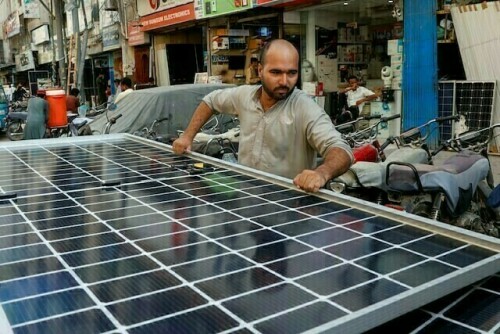China’s Solar Panel Exports to Pakistan Surpass Many G20 Nations
A research report released on Wednesday revealed that China’s exports of solar panels to Pakistan exceeded those to numerous G20 countries. In 2024 alone, Pakistan imported over 16 gigawatts (GW) of solar panels.
The report, entitled ‘Leader of One or Leader of None – China’s Choice for Clean over Coal in Pakistan’ and issued by the Renewables First think tank, indicated that Pakistan received more than 39GW of solar panels, primarily from China, within a mere five-year span.
According to the report, the volume of these solar panels is “sufficient to surpass three-quarters of Pakistan’s total installed national generation capacity”. The study further analyzed this shift, emphasizing China’s contribution within the Global South.
It stated that “The United States’ departure from the Paris Agreements plunged global climate action into disarray, leaving the world to ponder who, if anyone, would assume leadership in the battle against climate change.”
Pakistan’s Emergence as a Leading Solar Market
The report suggests that China has become a dominant force in clean energy manufacturing, providing renewable energy technologies utilized worldwide to combat climate change.
Pakistan has experienced an energy transition, referred to by the think tank as a ‘Solar Rush,’ which is propelled “not by governmental pronouncements or corporate decisions, but by rooftops, farms, and factory areas”.
The report elucidated the ‘Solar Rush,’ explaining how one of the world’s most rapidly expanding, citizen-driven solar markets developed not through extensive planning, but via open competition, accommodating trade policies, and a surge of affordable technology.
Despite the expansion of solar energy, investments in coal are becoming high-risk assets, as the nation still houses billions of dollars worth of Chinese-funded coal-fired power plants, according to the report.
As solar energy diminishes grid demand and increases the practicality of self-generation, these established plants, formerly regarded as cornerstones of energy security, are declining.
The report stated that “The use of these power plants decreased to as little as 4% in certain projects by 2024. Capacity payments increased, and electricity from the grid became more costly for those who still depend on it.”
Muhammad Basit Ghauri, the report’s lead author, commented that “China’s solar panels are surpassing China’s power plants. We are observing an unintended yet significant strategic paradox, with Pakistan at the forefront of this global energy disruption experiment.”
Challenges and Future Needs
With decentralized solar energy substituting centralized generation, Pakistan requires more than just panels. The report highlighted the necessity for storage systems, grid enhancements, local manufacturing, financial instruments, and a strategy to transition away from stranded coal assets.
“Pakistan may be the first to encounter this conflict between legacy coal and democratized solar on such a scale, but it will not be the last. If China navigates this successfully, it will not only facilitate Pakistan’s energy transition but also establish itself as the architect of a new Global South energy model that is rapid, equitable, and genuinely transformative,” the report concluded.



Comments (0)
No comments yet. Be the first to comment!
Leave a Comment